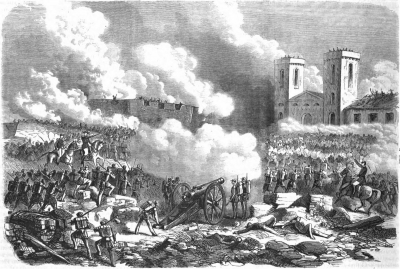The siege of Paysand began on 3 December 1864, during the Uruguayan War, when Brazilian forces (under Marquis of Tamandar) and Colorado forces (under Venancio Flores) attempted to capture the city of Paysand in Uruguay from its Uruguayan Army defenders. The siege ended on 2 January 1865, when the Brazilian and Colorado forces conquered the town.
The Uruguayan War (10 August 1864 – 20 February 1865) was fought between Uruguay's governing Blanco Party and an alliance consisting of the Empire of Brazil and the Uruguayan Colorado Party, covertly supported by Argentina. Since its independence, Uruguay had been ravaged by intermittent struggles between the Colorado and Blanco factions, each attempting to seize and maintain power in turn. The Colorado leader Venancio Flores launched the Liberating Crusade in 1863, an insurrection aimed at toppling Bernardo Berro, who presided over a Colorado–Blanco coalition (fusionist) government. Flores was aided by Argentina, whose president Bartolomé Mitre provided him with supplies, Argentine volunteers and river transport for troops.
The fusionism movement collapsed as the Colorados abandoned the coalition to join Flores' ranks. The Uruguayan Civil War quickly escalated, developing into a crisis of international scope that destabilized the entire region. Even before the Colorado rebellion, the Blancos within fusionism had sought an alliance with Paraguayan dictator Francisco Solano López. Berro's now purely Blanco government also received support from Argentine federalists, who opposed Mitre and his Unitarians. The situation deteriorated as the Empire of Brazil was drawn into the conflict. Almost one fifth of the Uruguayan population were considered Brazilian. Some joined Flores' rebellion, spurred by discontent with Blanco government policies that they regarded as harmful to their interests. Brazil eventually decided to intervene in the Uruguayan affair to reestablish the security of its southern frontiers and its regional ascendancy.
In April 1864, Brazil sent Minister Plenipotentiary José Antônio Saraiva to negotiate with Atanasio Aguirre, who had succeeded Berro in Uruguay. Saraiva made an initial attempt to settle the dispute between Blancos and Colorados. Faced with Aguirre's intransigence regarding Flores' demands, the Brazilian diplomat abandoned the effort and sided with the Colorados. On 10 August 1864, after a Brazilian ultimatum was refused, Saraiva declared that Brazil's military would begin exacting reprisals. Brazil declined to acknowledge a formal state of war, and for most of its duration, the Uruguayan–Brazilian armed conflict was an undeclared war.
In a combined offensive against Blanco strongholds, the Brazilian–Colorado troops advanced through Uruguayan territory, taking one town after another. Eventually the Blancos were left isolated in Montevideo, the national capital. Faced with certain defeat, the Blanco government capitulated on 20 February 1865. The short-lived war would have been regarded as an outstanding success for Brazilian and Argentine interests, had Paraguayan intervention in support of the Blancos (with attacks upon Brazilian and Argentine provinces) not led to the long and costly Paraguayan War.

1865Jan, 2
Uruguayan War: The Siege of Paysandú ends as Brazilian and Coloradans capture Paysandú, Uruguay.
Choose Another Date
Events on 1865
- 31Jan
Robert E. Lee
American Civil War: Confederate General Robert E. Lee becomes general-in-chief. - 13Mar
African-American
American Civil War: The Confederate States of America agree to the use of African-American troops. - 29Mar
Appomattox Campaign
American Civil War: Federal forces under Major General Philip Sheridan move to flank Confederate forces under Robert E. Lee as the Appomattox Campaign begins. - 4Apr
Richmond, Virginia
American Civil War: A day after Union forces capture Richmond, Virginia, U.S. President Abraham Lincoln visits the Confederate capital. - 6Apr
Appomattox Campaign
American Civil War: The Battle of Sailor's Creek: Confederate General Robert E. Lee's Army of Northern Virginia fights and loses its last major battle while in retreat from Richmond, Virginia during the Appomattox Campaign.

 English
English  español
español  français
français  português
português  русский
русский  العربية
العربية  简体中文
简体中文 